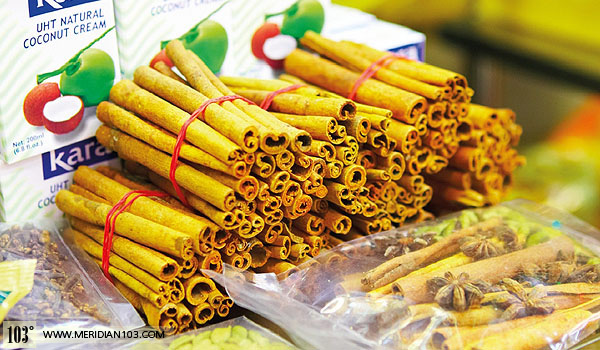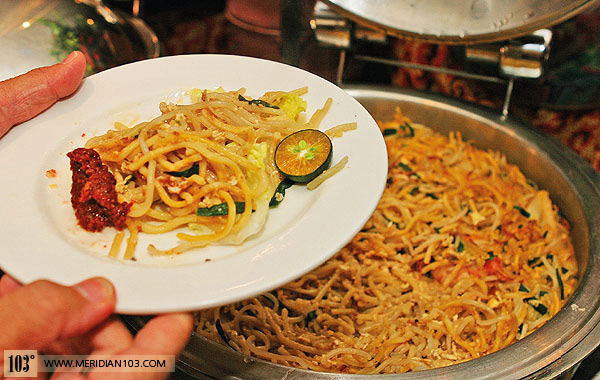IN LOVE WITH SINGAPORE NOSHSingaporeans have a love affair with the island's cuisine; its unique flavour, tempting aromas, visual impact and even preparation sounds distinguish Singapore food from the other cuisines of the world.
Truly, Madly, Deeply... in Love with Singapore Nosh
Food in the Lion City is always on its citizens' minds and on the tips of their tongues. Singaporeans' preoccupation with food is reflected in the most common greeting in Singapore: "Have you had your lunch yet " Quite befuddling to foreigners, it is a locally spiced-up version of the standard and bland generic greeting of "How are you "
Singaporeans can talk about their food passionately, in-depth and at great length, and miss it terribly when visiting other countries. You may not believe it, but Singaporean expats in Hong Kong are known to carry a bottle of chilli sauce when dining out, finding even other Asian cuisines not spicy or flavourful enough compared to that of home.

Ethnic Mix: Shaken, Not Stirred
Historically, Singapore cuisine is a unique blend of cooking traditions of Singapore's first immigrants: the Southern Chinese, mainly the Hokkien, Teochew, Cantonese and Hainanses; the South Indians from Kerala and Indian Muslims, as well as the native cuisine of the Malay Peninsula.
Different cultures can't help but influence each other, as they co-exist on a tiny island, which was established by the British as a port of call to bridge the East and the West. However, different culinary traditions still retain their original character. Indian cooking relies on dried seeds and hard spices like coriander, cumin, fennel, fenugreek, cloves, cinnamon and cardamom. The Malays use mainly fresh root spices, herbs and aromatic fruit skins such as galangal, lemongrass, turmeric and basil leaves. The Chinese were concerned with the "ying and yang" of cooking, using herbs and other ingredients to provide health and balance to the body.

Words Absent from the Russian Tongue... Not for Long, Though
In recent years, Japanese food has been extremely popular in Russia, with a new Japanese restaurant opening each week in major Russian cities. Today however, the Russian consumer is literally fed up with it and is ready for some novelty. Moscow's restaurants reacted quickly to the change in tastes by expanding their menus to include authentic Chinese, Vietnamese, Tibetan, Thai, Malay and Indonesian dishes. This was the prelude to the advent of the vast variety of palatable treats from the "Tiny Red Dot".
Exotic by their look and the sound of their names, "laksa", "satay" and "rendang" might soon take root in the Russian language, just as "sushi" and "pizza" already have, due to the efforts of the Singaporean government. It has taken the initiative to popularise Singapore's diverse cuisine globally, including in Russia.
According to Ms Jaisey Yip, IE Singapore's Centre Director for Moscow, "the F&B sector in Russia holds much potential and interest for our local food companies. With Russians' disposable incomes surging along with the country's unprecedented economic growth and its burgeoning middle class, there are many opportunities for Singapore's food industry to develop new and innovative concepts and products".
Tasty Singapore: Going Global
Singaporean cuisine has been promoted globally in key markets such as Americas, Middle East, Europe and Asia, through both IE Singapore, an agency under the Ministry of Trade and Industry which promotes the overseas growth of Singapore-based enterprises, and the STB (Singapore Tourism Board). The latter locally organizes the high-end World Gourmet Summit in April and the mass-market Singapore Food Festival in July.
In 2004, IE Singapore launched the Tasty Singapore initiative. It offers a collective brand identity for Singapore food companies venturing overseas and promote the authentic culinary cuisine and products that define Singapore's rich multi-cultural heritage.
There are currently 52 brand ambassadors who have met stringent hygiene and food safety standards that comply with the highest international requirements for food production. These producers append the distinctive orange Tasty Singapore logo on their products to differentiate themselves on the supermarket shelves from those from other countries.

|
 +65 6696 7068
+65 6696 7068
 info@meridian103.com
info@meridian103.com
 PDA
PDA
 +65 6696 7068
+65 6696 7068
 info@meridian103.com
info@meridian103.com
 PDA
PDA
